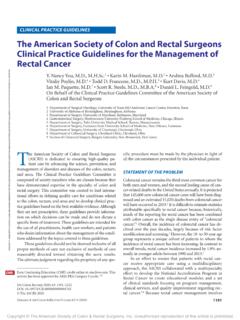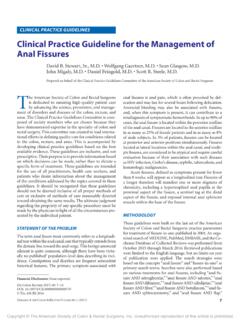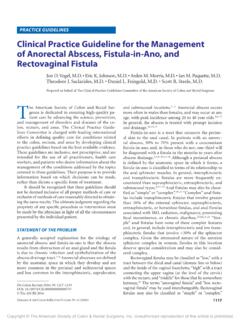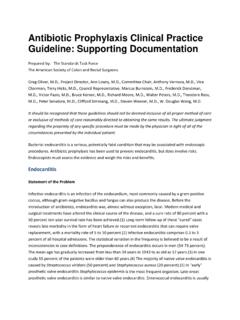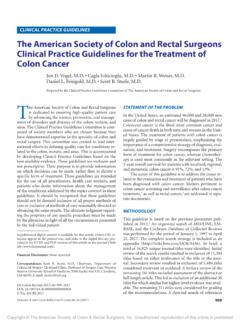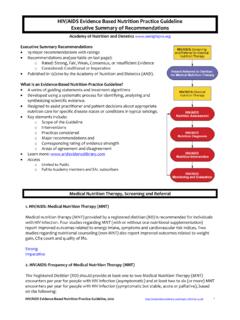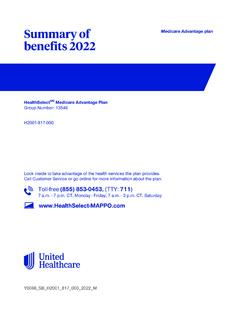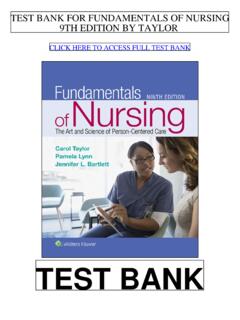Transcription of Clinical Practice Guidelines for Enhanced Recovery After ...
1 Clinical Practice Guidelines . Clinical Practice Guidelines for Enhanced Recovery After Colon and Rectal Surgery From the American Society of Colon and Rectal Surgeons and Society of American Gastrointestinal and Endoscopic Surgeons Joseph C. Carmichael, Deborah S. Keller, , Gabriele Baldini, Liliana Bordeianou, Eric Weiss, Lawrence Lee, , Marylise Boutros, James McClane, Liane S. Feldman, Scott R. Steele, 1 Department of Surgery, University of California, Irvine School of Medicine, Irvine, California 2 Department of Surgery, Baylor University Medical Center, Dallas, Texas 3 Department of Anesthesiology, McGill University, Montreal, Quebec, Canada 4 Department of Surgery, Massachusetts General Hospital, Harvard Medical School, Boston, Massachusetts 5 Department of Colorectal Surgery, Cleveland Clinic Florida, Westin, Florida 6 Department of Surgery, McGill University, Montreal, Quebec, Canada 7 Norwalk Hospital, Western Connecticut Medical Group, Norwalk, Connecticut 8 Department of Colorectal Surgery, Cleveland Clinic, Cleveland, Ohio KEY WORDS: Colectomy; Enhanced Recovery ; Ileus; The ASCRS Clinical Practice Guidelines Committee is com- Proctectomy.
2 Posed of society members who are chosen because they have demonstrated expertise in the specialty of colon and rectal T. his Clinical Practice guideline represents a collabora- surgery. In a collaborative effort, the ASCRS Clinical Practice tive effort between the American Society of Colon and Guidelines Committee and members of the SAGES Surgi- Rectal Surgeons (ASCRS) and the Society of Ameri- cal Multimodal Accelerated Recovery Trajectory Enhanced can Gastrointestinal and Endoscopic Surgeons (SAGES). Recovery Task Force and Guidelines Committee have joined together to produce this guideline, written and approved by All supplemental tables for these Guidelines are available at this link: both societies. The combined ASCRS/SAGES panel worked together to develop the statements in this guideline and ap- Financial Disclosure: The funding bodies (ASCRS and SAGES) did not in- proved these final recommendations.
3 Through this effort, fluence the content of this work and no other specific funding was received the ASCRS and SAGES continue their dedication to ensur- from other entities. Dr Keller is a member of the Pacira Pharmaceuticals ing high-quality perioperative patient care. speaker's bureau, and her institution has received unrestricted educational grants from Pacira. Dr Feldman has received grant support from Medtronic Previous Guidelines on perioperative care for colon1 and and Merck. Dr Carmichael's institution has received unrestricted educa- rectal2 surgery included studies identified up to January 2012. tional grant support for his work with Medtronic and Johnson & Johnson. with significant literature published since then. The com- bined ASCRS/SAGES committee was created to define cur- Liane S. Feldman and Scott R. Steele contributed equally to this article. rent best-quality care for Enhanced Recovery After colon and This article is being published concurrently in Surgical Endoscopy.
4 The arti- rectal surgery. This Clinical Practice guideline is based on the cles are identical except for minor stylistic and spelling differences in keeping best available evidence . These Guidelines are inclusive and with each journal's style. Either citation can be used when citing this article. not prescriptive. Their purpose is to provide information on which decisions can be made rather than to dictate a specific Correspondence: Scott R. Steele, , 9500 Euclid Ave/A30, Cleveland form of treatment. These Guidelines are intended for the use Clinic, Cleveland, OH 44915. E-mail: of all practitioners, healthcare workers, and patients who de- Dis Colon Rectum 2017; 60: 761 784. sire information about the management of the conditions DOI: addressed by the topics covered in these Guidelines . It should The ASCRS 2017 be recognized that these Guidelines should not be deemed in- DISEASES OF THE COLON & RECTUM VOLUME 60: 8 (2017) 761.
5 Copyright The American Society of Colon & Rectal Surgeons, Inc. Unauthorized reproduction of this article is prohibited. 762 CARMICHAEL ET AL: GUIDELINE FOR Enhanced Recovery . clusive of all proper methods of care or exclusive of methods METHODOLOGY. of care reasonably directed toward obtaining the same results. The ultimate judgment regarding the propriety of any spe- Members of the SAGES and ASCRS Practice Guidelines cific procedure must be made by the physician in light of all Committee worked in joint production of these Guidelines from inception to final publication. Final recommenda- of the circumstances presented by the individual patient. tions were approved by each society's committee and ex- ecutive council. These Guidelines were built following a STATEMENT OF THE PROBLEM standardized algorithm for the creation of all of our clini- cal Practice Guidelines , which included: search for existing Contemporary colorectal surgery is often associated with long Guidelines , formulation of key questions, a systematic re- length of stay (8 days for open surgery and 5 days for laparo- view of the literature, selection and appraisal of the quality scopic surgery),3 high cost,3 and rates of surgical site infec- of the evidence , development of clear recommendations, tion approaching 20%.
6 4 During the hospital stay for elective and drafting of the guideline. The details of specific search colorectal surgery, the incidence of perioperative nausea and strategies, including search terms, inclusion criteria, exclu- vomiting (PONV) may be as high as 80% in patients with sion criteria, total number of studies identified, and tables certain risk After discharge from colorectal surgery, of evidence for each statement, are available in the supple- readmission rates have been noted as high as ments, but all of the search strategies involved an organized An Enhanced Recovery protocol (ERP) is a set of standard- search of MEDLINE, PubMed, EMBASE and the Cochrane ized perioperative procedures and practices that is applied to all Database of Collected Reviews using a variety of key word patients undergoing a given elective surgery. In general, these combinations (for details on key words and search strate- protocols are not intended for emergent cases, but components gies see ).
7 System- of them certainly could apply to the emergent/urgent patient. atic searches were conducted from 1990 to 2016 and were Also known as fast-track protocols or Enhanced Recovery After restricted to English-language articles. Directed searches surgery (ERAS)1 protocols, the content of these specific proto- of the embedded references from the primary articles were cols may vary significantly, but all are designed as a means to also performed in certain circumstances. Prospective ran- improve patient outcomes. Outcomes of interest to patients and domized controlled trials (RCTs) and meta-analyses were providers include freedom from nausea, freedom from pain at given preference in developing these Guidelines . After all rest, early return of bowel function, improved wound healing, of the searches were complete, a total of 12,483 citations and early hospital Although numerous periopera- had been identified for title/abstract review, and 764 of tive protocols currently exist, this Clinical Practice guideline will those articles were selected for extensive review and placed evaluate the strength of evidence in support of measures to im- into evidence tables with ranking of the evidence based prove patient Recovery After elective colon and rectal resections.
8 On quality of the research by 2 independent reviewers (see A 2011 Cochrane review found that ERPs were associ- Tables S1 S14, ). ated with a reduction in overall complications and length The final grade of recommendation was performed using of stay when compared with conventional perioperative the modified Grading of Recommendations, Assessment, patient Subsequent studies have shown Development, and Evaluation system outlined previously that ERPs are associated with reduced healthcare costs and by the American College of Chest Physicians (Table 1).14. improved patient ERPs are also associated Previous Guidelines on perioperative care for colon1 and with improved outcomes regardless of whether patients rectal2 surgery included studies identified up to January undergo laparoscopic or open Studies have also 2012, with significant literature published since then. shown that ERPs cannot simply be implemented and for- gotten but require a continued audit process in place to guide compliance and to continue to improve 13.
9 PREOPERATIVE INTERVENTIONS. There are many different preoperative, intraoperative, A. Preadmission counseling and postoperative components in a typical ERP, and it is dif- 1. A preoperative discussion of milestones and discharge ficult to identify which are the most beneficial components criteria should typically be performed with the patient of the bundle of measures, because they are generally all before surgery. Grade of recommendation: strong rec- implemented simultaneously. However, one retrospective ommendation based on low-quality evidence , 1C. review of 8 years of compliance with an ERP identified these Standardized discharge criteria for patients undergo- items as the strongest predictors of shorter length of stay: ing colorectal surgery have been defined previously in no nasogastric tube, early mobilization, early oral nutrition an international consensus statement, which states that (early discontinuance of intravenous fluids), early removal patients are fit for discharge when there is tolerance of of epidural, early removal of urinary catheter, and nonopi- oral intake, Recovery of lower GI function, adequate oid This Clinical Practice guideline will evaluate pain control with oral analgesia, ability to mobilize, the evidence behind ERPs for colorectal surgery.
10 Ability to perform self care, no evidence of complica- Copyright The American Society of Colon & Rectal Surgeons, Inc. Unauthorized reproduction of this article is prohibited. DISEASES OF THE COLON & RECTUM VOLUME 60: 8 (2017) 763. TABLE 1. The Grading of Recommendations, Assessment, Development, and Evaluation system-grading recommendations14. Methodologic quality of Description Benefit vs risk and burdens supporting evidence Implications 1A Strong recommendation, Benefits clearly outweigh risk RCTs without important Strong recommendation, can high-quality evidence and burdens or vice versa limitations or overwhelming apply to most patients in evidence from observational most circumstances without studies reservation 1B Strong recommendation, Benefits clearly outweigh risk RCTs with important limitations Strong recommendation, can moderate-quality and burdens or vice versa (inconsistent results, apply to most patients in evidence methodologic flaws, indirect most circumstances without or imprecise)
